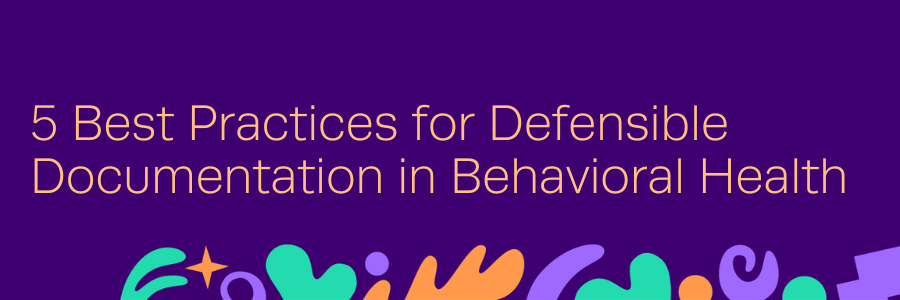5 Best Practices for Defensible Documentation in Behavioral Health

Welcome to the world of documentation! While it may not sound like the most thrilling topic, mastering the art of defensible documentation is crucial for delivering the best care and protecting ourselves from any legal or regulatory surprises. Let’s dive into the five best practices for defensible documentation!
Talk the Talk: Clear and Objective Language
Picture this: you’re reading a progress note that says, “The client seemed pretty down today.” Hmmm, what does “pretty down” mean exactly? To avoid confusion, document using clear and objective language. It’s important to stick to the facts. Describe specific behaviors, conversations, and measurable outcomes.
Time is of the Essence: Timely and Regular Documentation
In the fast-paced world of behavioral health, time flies. Timely documentation is essential. Capture the details while they’re fresh in your mind. Documenting immediately after a session or ASAP keeps the accuracy levels high and ensures your documentation is credible. So, don’t let procrastination take hold!
Consent, Confidentiality, and Coded Messages
We must honor two essential principles: informed consent and confidentiality. Before treatment, make sure your clients have given their consent. And when it comes to protecting identities, do not share classified information. To ensure that patient medical information is kept private and safe, the federal government passed the health insurance portability and accountability act (HIPAA), public law 104-191. The HIPAA Security Rule solely addresses the security of ePHI, or electronic PHI, that is generated, received, utilized, or preserved. Pro tip: use codes or unique identifiers instead of dropping real names. Another great resource for Confidentiality Regulations is SAMHSA.
Objective Assessments and Progress Measurements
When it comes to assessments, let’s leave no stone unturned. Use standardized tools and evidence-based measures to show the world that our work is legit. Want to measure progress in the best way ever? Quantifiable metrics, like rating scales or behavioral checklists, are your best friends. And don’t forget the power of clinical justification! Utilize standardized tools and evidence-based measures for assessments and capture tangible progress using quantifiable metrics. Clinical justification strengthens the credibility of your documentation, demonstrating that your interventions are grounded in evidence and tailored to meet your client’s unique needs.
United We Stand: Collaboration and Consultation
It is up to all of us to advance the behavioral health industry and save as many lives as possible. Embrace the power of collaboration and seek consultation when faced with challenging cases. Document these epic collaborations and showcase your commitment to professional growth on social media.
Now that you know the five best practices, you can master defensible documentation! By using clear and objective language, documenting in a timely manner, respecting consent and confidentiality, conducting objective assessments, and embracing collaboration—you’re well on your way to superhero status in the world of documentation.
But… how do you implement this new knowledge into your facility? You can provide staff education and training including peer review, consulting legal and compliance experts, doing self-audits, or using an EMR, such as Kipu, that supports defensible documentation by using templates, prompts, or reminders to ensure completeness and accuracy. When it’s done right, documentation can be a superpower that ensures exceptional care and protects us.
Rely on Kipu to keep you ahead of change.
Subscribe to Kipu for behavioral health news, updates, community celebration, and product announcements.




